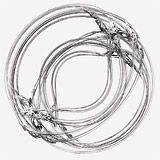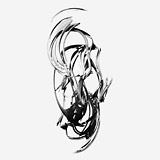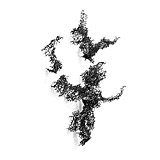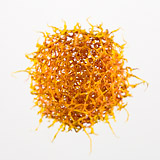| Aljoscha | |
| installations | |
| interventions | |
| p-landscapes | |
| statement | |
| exhibitions | |
| publications | |
| bibliography | |
| cv | |
|
Sculptural Objects in Suspension Between Art and Science Presented now for the first time in a solo exhibition are the charming and mysterious objects of Aljosha. Born Aleksey Alekseevich Potupin in Glukhov (Ukraine) in 1974, Aljosha has over the past 10 years produced an astonishing oeuvre consisting of objects, drawings, watercolors, and paintings. With its focus on the objects, this exhibition offers insights into the conceptual and aesthetic world of a young artist who draws inspiration from the discoveries of biotechnology and genetics - that is to say, the so-called life sciences. He is fascinated by the microcosmic qualities of extremely fine materials, and from the intellectual resources provided by this singular perspective, he creates art objects having little in common with those by other artists. In these conceptually oriented, extraordinarily delicate, purist sculptures, made of acrylic paint, he transfers his striking talent as a draftsman into three dimensions. From the very first encounter, Aljosha’s objects cast their microscopic spell over me. My collaboration with the artist in recent months has provided additional insights into his enthralling miniature world. We congratulate Aljosha, who has just received 1st Prize in the category of sculpture from the XXXV Premio Bancaja Valencia. This wondeful news arrived during praparations for his premiere solo presentation, which will take place in our gallery. On the natural-scientific context of Aljosha’s works Receiving renewed attention during the past decade has been the reciprocal influence between the arts and sciences. For artists, the processes of visualization utilized in the natural sciences have meant heightened access to an astonishing “scientific image world” – both as source of inspiration and as method. The process set in motion by the discovery of the microscope and continued with the inception of scientific photography - which is to say: the discovery of a hitherto invisible microworld, a realm of beauty previously unavailable to the arts - is now being further elaborated on an expanded scale via the development of procedures of simulation and calculation in the realm of the natural sciences, of modes of visualization involving tonal and chromatic contrasts. Not only are aesthetic factors playing a role in scientific phenomena. Their visualization is now strongly conditioned by design/artistic resources. Under these circumstances, it has become impossible to say with precision where nature ends and art begins. The term “science art” has established itself to refer to such profound interfaces between disparate realms.[1] In his essay on the interplay between these two boundary regions, mathematician and physicist Herbert W. Franke shows how often the considerable creative potential generated by information exchanges between customarily separate areas leads to innovation.[2] A concrete instance of the relevance of such an interrelationships in Aljosha’s art is his preoccupation with mathematical models in the context of his experimental search for the perfect natural form. Using formulae invented by the French mathematician Maurice Gaston Julia, he employs scientific calculations dealing with symmetry / asymmetry / spatial complexity, endowing these with concrete form as computer-generated images.
Aljosha’s formulation is provocative and futuristic. Along with his current claims to be working out a new aesthetic, one representing the vitality and complexity of future living organisms, his desire to work with living organic material remains utopian for the time being. “Living” Architecture A precondition for approaching the aesthetic embodied in these objects is an initiation into the artist's idiosyncratic mental world. These extraordinarily delicate, three-dimensional architectural objects are made of acrylic paint. Aljosha chose this material as his medium, and has exploited it in its most varied material states and chromatic combinations, whether through heating, through treatment with transparent acrylic varnish, through the engraving of miniscule strands of paint, or through its association with plastic, paper, or wire frameworks, the latter designed to provide the larger sculptures with stability. Frequently observable is the temptation on the part of viewers to touch these objects in order to fathom their mysterious, semitransparent materiality. The originally liquid paint is diverted toward new physical states, thereby symbolizing the extension of the painting medium into three dimensions. As so often observable in contemporary sculpture, art is once again capable of canceling the intended function of any given material and diverting it toward its own aims, converting it to serve the purpose of autonomous aesthetic play.[6] Notable too in this context are the works which mark out stages between image and object: these seem almost to grow directly out of the canvas. Just like genetic recombinants, each work is a structural and material unicum, and each amounts to an experiment in the use of materials: the “building plan” is never predetermined, and each work has the feel of an open system capable of subsequent development. In the context of his claim to invest his objects with “life,” the artist interacts with them in a playful spirit, configuring them in so-called “object families.”
Alongside their specific constitution and materiality, these objects (and in particular the small ones) possess the tender beauty of coral. They seem to have formed themselves organically, to have assumed shapes only nature is capable of producing. Transparency and fragility are among the basic traits of this aesthetic. Especially with the white objects (which the artist prefers to see displayed against white walls), the play of shadow plays a special role. Many of Aljosha’s sculptures are radically purist in appearance, but could also be circumscribed with the term “futuristic,” understood here in the sense of modern design tendencies strongly influenced by an enthusiasm for science and technology. Although this catalog concentrates on the objects, it is important to mention that as a rule, each one also exists in the form of a pencil drawing. Each drawing is produced only after the respective sculptural object. Yet according to the artist, they nonetheless represent the object’s quintessence. His fascination for the microcosmos of physical materiality, then, also finds expression on paper. There, Aljosha reduces the object quality almost to the point of total dematerialization; remaining are only abstract hair and feather structures. Although contrasting radical with the clamoring for attention seen in large and overbearing formats, the powerful effect of these objects is present even at first glance - seemingly a product of the artist’s microscopic gaze, which is the source of the extreme degree of detail seen in these works. The precision demanded of the gaze endows these objects with an irresistible force, one that draws the viewer into their interior life. Playing a decisive role in the reception of this art, in my view, is this miniaturizing perspective. This approach, moreover, opposes our currently prevalent sense of time, with its orientation toward maximization and high velocity. In my view, this kind of “deceleration” also reflects a fundamental trait of this artist, namely his love of purity, of objects that have been created with intense devotion and precision.
Dürer, Klapheck, BioArt: An Attempt at Classification This descriptive analysis leads inevitably to questions of art-historical references, and of how these objects are to be situated in the context of current sculptural production. Aljosha himself rejects all such references. To be sure, technical parallels could be located in the art of Albrecht Dürer. While Dürer is celebrated for his major graphic works, often involving mythological or allegorical themes, of greater relevance in our context are his depictions of the natural world, in particular his painstaking detailed and phenomenally scrupulously small-scale renderings of plants and animals. Such works call attention to objects that normally remain concealed from the viewer. Something similar could be said of the neorealistic works of Konrad Klapheck, whose lectures at the Düsseldorf Art Academy Aljosha audited for more than two years. Klapheck’s paintings and drawings set everyday objects, tools, or mechanical devices before the viewer's eyes in the form of oversized and slightly alienated protagonists or icons. He is concerned with powerful and universal formal beauty, and with lucid contours that are captivating in their simplicity. This aesthetic of clarity too seems to be reflected in Aljosha’s works. Points of convergence with classical Modernist sculpture could conceivably be found in the minimalism of the 1950s and 1960s, especially in the biomorphic sculptures of an artist like Hans Arp, their surfaces evocative of a singular sensuality. But Aljosha emphasizes that it is less a question of sculpture as traditionally understood than of “objects” – of works which, incidentally, are simply numbered and dated rather than being provided with titles. At this point, our attempt to situate Aljosha’s production in contemporary artistic discourse should mention the tendency having the greatest proximity to his own approach, so-called “BioArt.” This specialized area of the avant-garde emerged in the late 1990s, and revolves exclusively around art consisting of biological materials (i.e. animals, plants, bacteria, organic systems), or else is generated via biotechnical processes (i.e. the deployment of gene technology, with synthetic genes being implanted into living organisms, or natural genetic material being transferred from one species to another, thereby generating unique life forms). A prominent exponent of this tendency is Brazilian artist Eduardo Kac, who has already produced a number of internationally acclaimed works of BioArt, some of them found in the permanent collections of the Museum of Modern Art in New York and the Museum of Modern Art in Rio de Janeiro. Among his best-known projects is a transgenic, green fluorescent rabbit named Alba (“GPF Bunny 2000”), produced in collaboration with a team of geneticists, a project which encompasses public discussions concerning this startling creature, which even found its way onto the front pages of daily newspapers internationally.[7] For the project “Specimen of Secrecy about Marvelous Discoveries,” presented at the Singapore Biennale in 2006, Kac created series of six “biotopes” within which he raised living biocultures in water, earth, and other materials, all remaining in states of perpetual development, their appearances transformed continually in response to their internal metabolisms and to the external conditions of the exhibition.[8] Kac has also dealt with the historical, theoretical, and ethical implications of this topic. In a volume of materials on the topic of BioArt which Kac assembled in 2007, he brought together the voices of internationally recognized natural scientists, cultural theoreticians, and artists, delimiting the concept of BioArt in relation to related artistic tendencies and practices: “Bio art must be clearly distinguished from art that exclusively uses traditional or digital media to address biological themes, as in painting or sculpture depicting a chromosome or a digital photograph suggesting cloned children. Bio art is in vivo. (…) Further, in its specificity bio art cannot be classified as ready-made, conceptual art, situationism, or social sculpture.”[9] This definition makes it clear that Aljosha’s works cannot be directly aligned with the BioArt tendency. Of course, Aljosha shares BioArt's intense preoccupation with biotechnical progress, but in contrast to it, neither adapts nature nor influences it, but instead creates novel art objects in a way that is instigated by natural-scientific knowledge. And if he should come to work with living material in the future, then he would aspire to actively shape its aesthetic, not simply to interpret it. This crucial distinction can be emphasized by citing art historian Horst Bredekamp in the following passage, which is highly apropos of the relationship between art and science: “Unquestionably, the rise of the new media, the diffusion of the computer and the cultural dominance of the life sciences has influenced the realm of art to the highest degree. Posing itself against this background is the problem of how to deal with the phenomena now confronting artists. There have always been rapprochements between art and novel technological developments. As a rule, however, these have resulted in industrial or scientific kitsch. (…..) Seen objectively, the far more important processes occurring in the art world are those which follow these processes independently, and which succeed in viewing them from a distance, whether via irony or other means.”[10] Despite the provocative content found in some of his artistic statements, it seems to me that Aljosha’s art maintains a sense of distance in relation to science, a distance that remains essential for reception of his work, and which, in the end, justifies their presentation in an art context. For myself and on behalf of Ute Eggeling and Michael Beck as well, our sincerest thanks to Aljosha for an intensive and thoroughly enjoyable collaboration. All of us regard it as a tremendous privilege, but also as a responsibility, to have worked together with this artist in organizing his first solo exhibition. It is a pleasure for us to follow his work’s continual development. Still in early stages of development, but having enjoyed an initial success, there now exist variations on objects in bronze as well as those in new and much larger dimensions. In particular for the sake of the drawings and paintings, which were not discussed here, we look forward to an ongoing collaboration. Antonia Lehmann-Tolkmitt Literature: · Markus Buschhaus, Über den Körper im Bilde sein. Eine Medienarchäologie anatomischen Wissens. Münster, 2005. · Corina Caduff, “Experiment Klon,” in Thomas Macho and Annette Wunschel (eds). Science & Fiction. Über Gedankenexperimente in Wissenschaft, Philosophie und Literatur, Frankfurt, 2004. · Herbert W. Franke, “SCIENCE ART,” in Mersch, Dieter and Ott, Michaela (eds.), Kunst und Wissenschaft, Munich, 2007, pp. 183-190. · Hirshhorn Museum and Sculpture Garden; Smithsonian Institution (ed.), The Uncertainty of Objects and Ideas: Recent Sculpture, New York, 2007. · Eduardo Kac (ed.), Signs of Life – Bio Art and Beyond, Cambridge & London, 2007. · Dirk Luckow, in (same author, ed.), Plastik. Eine Ausstellung zeitgenössischer Skulptur (catalog to the exhibition in the Württembergischer Kunstverein in Stuttgart, 8 February to 30 March 1997, and the Städtische Ausstellungshalle Am Haverkamp in Münster, 12 October to 30 November 1997). · Thomas Macho, “Angst vorm Doppelgänger. Klone und künstliches Leben kennen wir längst – aus Literatur und Film. Aber auf eine reale Existenz wären wir niemals vorbereitet,” in Die ZEIT 06/2008, p. 49. · Barbara Maria Stafford, Horst Bredekamp, “Wissensgesellschaft und Picturial Turn – Ist die Wissensgesellschaft eine Bildgesellschaft? Ein Gespräch mit Stefan Iglhaut und Thomas Spring,” in Iglhaut & Spring (eds.), Science + Fiction. Zwischen Nanowelt und globaler Kultur, Berlin, 2003. pp. 65-89. · Exhib. cat., Genesis: Life at the end of the information age, Utrecht, 2007. [1] See Herbert W. Franke, “SCIENCE ART,” in Dieter Mersch and Michaela Ott (eds.), Kunst und Wissenschaft, p. 184. [2] Ibid. p. 183. Franke has given various courses on the interlocking of art and science and on computer art, and is a cofounder of ARS ELECTRONICA in Linz. [3] Corina Caduff, “Experiment Klon,” in Thomas Macho and Annette Wunschel (eds.), Science & Fiction. Über Gedankenexperimente in Wissenschaft, Philosophie und Literatur, p. 231ff. The author supports his claim by referencing, among other things, the negatively inflected debate around Peter Sloterdijk’s “Regeln für den Menschenpark,” published in 1999, and Michel Houllebecq’s novel “Elementarteilchen” which appeared in the same year, both of which optimistically contemplate the possibility of human cloning. [4] Christian Stöcker, “Gentechnik-Sensation: Forscher schaffen erstmal komplette künstliche DNA,” in http://www.derspiegel.de/wissenschaft/mensch/0,1518,530844,00.html. [5] http://www.bioism.info/statement [6] See Martin Hentschel, “Vorwort,” in Dirk Luckow (ed.), Plastik. Eine Ausstellung zeitgenössischer Skulptur, p. 2. [7] Eduardo Kac, “Life Transformation – Art Mutation,” in Eduardo Kac (ed.), Signs of Life. Bio Art and Beyond, p. 167ff. [8] See. http://www.ekac.org/ [9] Eduardo Kac, Introduction to Art that Looks you in the Eye: Hybrids, Clones, Mutants, Synthetics, and Transgenics, p. 19. [10] Barbara Maria Stafford and Horst Bredekamp, “Wissensgesellschaft und Picturial Turn – Ist die Wissensgesellschaft eine Bildgesellschaft? Ein Gespräch mit Stefan Iglhaut und Thomas Spring,” in Science + Fiction. Zwischen Nanowelt und globaler Kultur, p. 69f. |
||||||||||||||||||||




